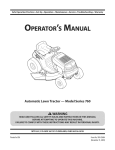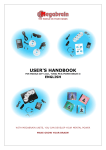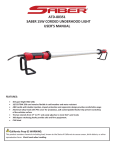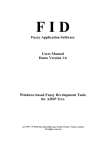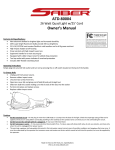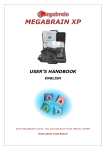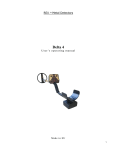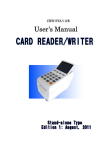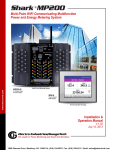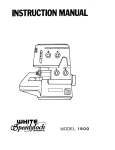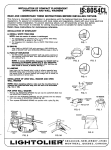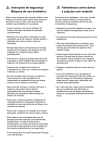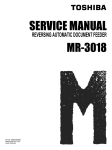Download HQ Portable Professional Frame Setup Letter PRINT.indd
Transcript
HQ Portable Professional Frame Setup Instructions 05/05/10 © 2010 Handi Quilter, Inc. Designed by a Quilter, for Quilters.® 1. Assembling the HQ Portable Professional Frame 1.1 Thank you for purchasing the HQ HQ Portable Professional Frame. This frame is adjustable to fit tables up to 101/2 feet long for crib-size to king-size quilts. We recommend that you set it up at the longest length that will fit in your room. To begin setting up this frame, remove the continuous tracks from box. Bow in opposite direction until they lay flat on the table. 1.2 Place the bases over the tracks at each end of the table. A groove is cut into the base to fit over the track. Note: The track nearest the edge of the table is the back track. 1.3 Clamp the bases securely at the end or side of the table with two clamps on each base. The clamps can be placed anywhere along the base allowing the frame to be set on most tables. However, 30 inch wide tables are most desirable. There are holes in the bases that align with holes in the Adjustable Table ends that can be used to bolt the frame to the table, if desired. 1.4 Command® Strips are provided to secure the tracks to your table. Place the carriage on the tracks and roll the carriage along, placing strips on the underside of the track as you roll. Place the strips perpendicular to the track and allow the non-adhesive end to extend beyond the track, to aid in removal if needed. 1.5 Locate the side arm with 3 Yshaped latches. Place this arm on the outside of the base on the right side of the table (when standing at the front of the table). Each side arm has multiple sets of holes to bolt into the base. Use the middle set of holes to begin with, but do not tighten the bolts firmly until you have placed the carriage and machine on the tracks and have confirmed that this is the best setting. 1.6 Bolt the arms to the bases with the bolts and nuts provided. While standing at the front track, the arm with the latches is bolted to the base on your right side. 2 HQ Portable Professional Frame 1.7 Once the right arm is securely bolted to the base, the setup should look like this. Repeat the process to install the arm on the left side of the table. 1.10 Create four 10 1/2’ poles in the following order: First, add a 4” section to each gear section to create three 8’ poles. Then add a 2 1/2’ section to the end opposite the ratchets to complete a 10 1/2’ pole. Combine the remaining 3 pole sections in the same order to create an Idler pole. Pole Identification Take-up pole has a black grip. Idler pole has no ratchets. Quilt Top pole has one ratchet. Backing pole has one ratchet. 1.8 After confirming that this is the best setting, tighten the bolts using a 7/16” socket or wrench. Level the arms as you tighten the bolts. This step takes place after checking the setting when you place the carriage and machine on the tracks. 1.9 Identify the pole sections. There are three 4’ sections with ratchets (one has a black rubber grip), five 4’ sections and four 2 1/2’ sections. 1.11 Install the Take-up pole Slide the end with the 2 1/2’ section into the top hole on the left side arm (standing in front of the table). NOTE: If desired, frame can be adjusted to fit different table lengths by using different combinations of pole sections. While pushing in the snap button, slide the pole through the top hole on the right side arm. Install the remaining poles In the same fashion, install the Idler pole below the Take-up pole. The Quilt Top pole and Backing poles are installed in the two front pairs of holes. 3 HQ Portable Professional Frame Join the pole sections together by using the provided couplers. Press the snap button and push the coupler inside the adjoining pole until the pin pops out of the hole. 1.12 This photo shows the frame set up at 8’. 1.13 Next, prepare to attach the Velcro® to the poles. Measure in 6” from each end of the frame. 1.14 Peel the backing off the Velcro® and apply to the Take-up pole, starting at the 6” mark and ending at the opposite 6” mark. Use the snap buttons as a guide to keep the Velcro straight. It is recommended that you place the Velcro in a line below the buttons. Repeat to apply Velcro® to the Quilt Top pole and the Backing pole. Do not put Velcro® on the Idler pole. 1.15 Once the Velcro® has been applied to a pole, it can be clipped at the couplers to enable diassembly. If you don’t intend to change the size of your frame, the Velcro® can be left uncut. 1.16 A set of 9 1/2’ marked leaders are provided with this frame. Fold each leader in half lengthwise and mark the center. 1.17 Matching leader center marks to pole center marks, begin attaching the leaders to the Velcro® , working from the center to each end of the Quilt Top pole and Backing pole so Measure and mark the center of the they hang to the center between the Take-up pole, Quilt Top pole and poles. Backing pole. 4 HQ Portable Professional Frame 1.18 In the same fashion, attach the remaining leader to the Take-up pole, so the leader falls to the back of the frame. Next, refer to the Q Drive user manual for instructions for placing the carriage and machine head on the frame. 5 HQ Portable Professional Frame 2. Loading a Quilt the fabric from the center out to the left and then the center out has been sufficiently caught by Loosely to the right. It does not matter which direction you woven fabrics can pull through close to the raw edge. Always begin the p attach first as long as you always begin in the center. process from the center out to each side. Matching up the center of the leader with pin on your backing, begin pinning the f attached to the bellynot bar.overlappin (the belly Place the pins end to end, Matching up the center of the leader withleader the center first pole closest to your belly). The fabri leaving big gaps between pins. Be consi pin on your backing, begin pinning the fabric to the Find the center of your backing fabric being 1/8”within beyond leader to placing the pins theyour serged stitchi leader attached to the belly bar. (the bellyextend bar is about the aware if the fabric is directional. the fabric has been sufficiently caught by leaders. first pole closest to your belly). The fabric should woven fabrics can pull through i extend about 1/8” beyond your leader to Loosely assure that close to the the fabric has been sufficiently caught by the pins. raw edge. Always begin the p process Loosely woven fabrics can pull through if pinnedfrom too the center out to each side. close to the raw edge. Always begin the pinning 2.2 Matching of theout leader process the fromcenter the center to each 2.3 side.Place the pins end to end, not with the center pin (or mark) on the overlapping the pins, or leaving big backing, begin pinning the fabric to gaps between pins. Be consistent in the leader attached to the Backing With ratchet engaged, rollor the backin placing thethe pins within hem Place the pins end tothe end, not overlappin pole. The fabric should extend about pole,serged being careful smooth fr leaving big edge gaps between pins.wrinkles Be consi near the ontothe lead1/8” beyond the leader to assure ter out to the edges. As long as the ratche theor pins within the serged stitchin ers. placing Place the pinsa end to end, not overlapping the pins, Place pin on the center mark. that the fabricbig hasgaps beenbetween sufficiently in theingears, the fabric will be rolled in th leaders. leaving pins. Be consistent caughtplacing by the the pins. direction. pins within the serged stitching on the shows a leader with (NOTE: Photo leaders. a serged edge, which may be difLoosely woven fabrics can pull ferent from the leader that was through if pinned too provided with the Pro-Frame. The closely to the raw edge. Always begin technique for loading is the same, the pinning process from the center regardless of the type of leaders out to each end. used.)With With the wrong side of the backing fabric facingthe up,ratchet engaged, roll the backin pole, being drape the fabric over the take-up roller. This gives youcareful to smooth wrinkles fr ter out to With the ratchet engaged, roll the backing onto the a good visual that the fabric is oriented correctly. the edges. As long as the ratche infloor) the the fabric willroll be that rolled th pole, being carefulup, to smooth wrinkles from thegears, cen-Watch (Wrong side facing right side facing the as you theinedg direction. ter out to the edges. As long as the ratchet is engagedric is not hour-glassing, rathe in the gears, the fabric will be rolled in the correct top of itself. direction. 1. Pinning the Back 2.1 Pinning the Back. Note: 2” long sharp pins with large pear-shaped heads are recommended for all pinning steps. Find the center of the backing fabric, being aware if the fabric is directional. 2.4 With the ratchet engaged, roll the backing onto the pole, being careful to smooth wrinkles from the center out to the edges. As long as the ratchet is engaged in the gears, the fabric will be rolled in the correct direction. 2.5 While rolling, gently “massage” 2.6 Shown is an example of rolled the fabric from the center to the fabric that is hour-glassing, not edges, so that the edge of the fabric rolling precisely on top of itself. does not “hour glass” (pull to the Watch as you roll that the edg center from both edges) or shift to ric is not hour-glassing, rather one side or the other. fabric top of itself. WatchThe as you roll that the edge of the fabshould roll precisely of ric is on nottop hour-glassing, rather rolling on itself. See “hour-glassing” top of itself.example in next photo. 6 HQ Portable Professional Frame As you roll, use the seams in your back as a guide to keep the fabric straight. This seam is not even so it needs to be adjusted. 2.7 While rolling, use the seams in the back as a guide to keep the fabric straight. Massage the fabric to any unevenness. 2.8 “Massage” the fabric to the fabric2.9 seam out is now parallel to the Massage to The straighten any unevenness. Backing pole. straighten out any unevenness. This seam is not parallel to the pole, so it needs to be adjusted. The seam now runs st the horizontal line of t The seam now runs straight along the horizontal line of the pole. 7 HQ Portable Professional Frame mark. 3. Loading the Quilt Top 2. Loading the Quilt Top With the right side of the fabric facing up, drape the quilt top over the take up roller. 3.1 Fold the quilt top to find the center. Place a pin at the center mark. Find the center of your quilt top. Place a pin at the center mark. 3.2 With the right side of the fabric facing up, drape the quilt top over the Take-up pole. 3.3 Match the center of the leader to the pin on the quilt top and begin pinning the quilt top to the leader from the center out to the edges. Match the center of the the pinofonthe yourfabric facWith theleader rightto side quilt top and begin pining up, drape the quilt top over the ning from the center out take up toroller. the edges. Wea end bett Use your piecing as a guide when y on the pole. You can see the seam is massage the fabric until it is straigh Weave the pin at both ends so the fabric is better anchored. 3.4 Weave the pin at both ends (take 2 or 3 “bites with the pin) so the fabric is well-anchored. Match the center of the leader to the pin on your quilt top and 3.6 begin pin3.5 Use the piecing as a guide This seam is is parallel to the center when rolling the fabricning from theQuilt Topout pole. to the edges. on the pole. If a seam is not straight, massage the fabric until it is parallel to the Quilt Top pole. Seam is straight horizontally. 3. Weave the pin at both ends so the fabric is 3. Loading the take up roller better anchored. 8 HQ Portable Professional Frame Release the ratchet on your belly bar 3. Loading the take up roller 4. Loading the Take-up pole Release the ratchet on your belly bar 4.1 Release the ratchet on the Backing pole. Unroll some of the backing fabric, bringing it under the Quilt Top pole. Bring the leader from the Take-up pole forward, passing it under the Idler pole. Find the position where the quilt back lines up naturally with the leader. under the pole that the top fabric rolled on. Bring the leader from t take up roller forward passing un the idler bar. (Idler bar is at the b under the take up roller with no V attached.) Find the position where quilt back lines up naturally with leader. Unroll the backing fabric bringing it under the pole that the top fabric is rolled on. Bring the leader from the take up roller forward passing under 4.2 thebar. leader to bar theisbacking thePin idler (Idler at the back fabric, beginning at the center under the take up roller with noand Velcro working toward each edge. where the attached.) Find the position quilt back lines up naturally with the leader. 9 HQ Portable Professional Frame Begin pinning the leader and the backing fabric from the center out as you have done previously. Begin pinnin backing fabr you have do 5. The batting 5.1 Gently place the batting between the Backing pole and the Quilt Top pole, being careful not to stretch the batting. Bring the batting up to the top pinned edge of the backing fabric. If using a flat batting, such as a needle-punched cotton/poly, basting the batting to the backing fabric is recommended. If using a fluffy batting (such as a thick polyester), this step must be skipped, because the hopping foot gets caught in the batting fibers. Tip: Channel lock is a great tool for squaring a quilt on the frame. Tip The batting Place the 4. channel lock on one of the front Channel lock is a great t wheels of the machine. on the frame. Gently place your batting between the quilt backing Place the channel lock o pole and top pole, being careful not to stretch the batwheels of the machine. ting. Bring the batting up to the top pinned edge of your backing fabric. 5.2 With the channel lock in Tip: For basting a straight line place, stitch a plumb line (straight across the quilt, a channel lock is horizontal linea across the top recommended. the channel WithPlace the channel locked attached, stitch edge of the batting). Tip: lock on oneplumb of theline front wheels (straight horizontal line across the This creates a Channel a batting). great for squaring a quilt straight toa use as a guide for of the machine to lock help stitch a toolThis top edge of is the givesline you on the frame. the next step. horizontal straight line. line to place the edge of your quiltWith top the channel locked Place the channel lock on one of the front on before you begin your quilting. plumb line (straight hori wheels of the machine. top edge of the batting). straight line to place the on before you begin you stitching plumbstitch line, arelease the With theAfter channel lockedthe attached, ratchet on the quilt topline pole and the bring the plumb line (straight horizontal across quilt top edge up to the stitching top edge of the batting). This gives you a line. straight line to place the edge of your quilt top After stitching the on before you begin your quilting. ratchet on the qui quilt top edge up 5.3 After stitching the plumb line, release the ratchet on the Quilt Top pole and bring the quilt top edge up to the stitching line. (If using a fluffy batting with no basting, simply align all three edges, backing, batting and quilt top, keeping them parallel to the Takeup pole leader. 5.4 Slide the end of the side Note: The clamps are used to stabilize the quilt backing only. clamp’s Velcro® tape through the slit in the side arm. Grip the back- They are not to be used to stretch ing fabric securely with the clamp. the backing, which would result In some cases, the batting may in quilting problems. also be caught in the clamp. It After stitching the plumb line, release the depends on howratchet wide the backing on the quilt top pole and bring the fabric and batting are. Doedge not up grip quilt top to the stitching line. the quilt top. Pull the Velcro® tape until the quilt is just taut, then attach to the Velcro® strip on the side arm. 10 HQ Portable Professional Frame desire. You can use the clamp as is or you can use the Velcro strap and pin to the backing. When using the ruler base this works very well. Notice the wider backing fabric. You can use 2 clamps pe Tighten the fabric so there is gent across the top edge within 1/8”. T ing should encase this basting. A sure with your left hand to help el tucks. 5.5 When doing ruler work, the ruler base can bump into the side clamp. To work around this, consider reversing the clamp and pinning the Velcro tape end to the quilt backing. 5.6 Two clamps per side may be used if desired (not included). 5.7 After stabilizing the backing fabric with clamps, the next step is to stabilize the top of the quilt top. Place vertically about every 6 You can use 2 clamps per sidepins if desired. inches within the top 3”-4” of the quilt top. Place some pins vertically about every 6 inches to stabilize the fabric. Each time you roll the quilt you w down the left edge within 1/8”. U hand to apply gentle pressure to s straight line. Tighten the fabric so there is gentle tension. Baste across the top edge within 1/8”. The finished binding should encase this basting. Apply gentle pressure with your left hand to help eliminate any tucks. 5.8 Turn the poles to tighten the fabric so there is gentle tension. Baste across the top edge within 1/8”. The finished binding will encase this basting, so it won’t show. Apply gentle pressure with the left hand to help eliminate any tucks. 5.9 Next, slowly baste down the left edge, again within 1/8” of the edge of the fabric. Use the left hand to apply gentle pressure to help stitch a straight line. This step ensures a stable beginning to each quilting pass. Finally, stabilize the right side. There are two accepted methods (and two schools of thought) for this step. 1. Stabilize with pins placed horizontally (perpendicular to the edge of the quilt top) about every 6”. Leaving the right side unbasted provides space for any fullness to move while quilting. OR Note: Each time the quilt is rolled 2. Baste down the right side (within onto the Take-up pole, it is impor- 1/8” of the edge) in the same manner Each time you the quilt as you tant that the left edge beroll basted. thewill left baste side. This helps to prevent down the left edge within 1/8”. Use your tucks from forming in the backing hand to apply gentle pressure to stitch fabric whileaquilting. straight line. 11 HQ Portable Professional Frame Whichever method you choose, be sure to stabilize the right side before beginning the quilting pass. A d Y s b f 6. Correct Fabric Tension 5. Correct Fabric Tension tensioned too tigh Fabric tensioned too tight causes polesFabric to bow. bow. Quilt loaded properly ready for quilting. 6.1 This photo shows a quilt loaded properly and it is ready for quilting. 6.3 This photo shows the fabric 6.2 Do not roll the Take-up pole tensioned correctly. There should be too tight. Fabric tensioned too barely enough room to fit a finger Fabric tensioned causesthepoles tight causes poles to bow. This too tight between pole to and the bed of Fabric tensioned correctl Fabric correctly. You should have bow. photo shows poles that tensioned were machine. When these results are enough room to fit youritfinger obtained, is timebarely to go back and room to fi rolled too tight, barely so the enough pole bows tighten the bolts holding the side between the pole and the the space pole and the bed of machine. upward, allowingbetween too much between the idler pole and the bed of the machine. If there is enough room for a hand (as shown), the tension is too tight. arms to the bases (as discussed in the Assembling the HQ Portable Professional Frame Step 1.7). Note: If the fabric is tensioned correctly and there is still too much room between the fabric and the bed of the machine, then the side arms are set too high. To correct, lower the side arms, tighten the bolts, and recheck. Fabric tensioned correctly. You should have The enough backingtension is too loose. Not enough The fabric Not on fa barely enough tension room to on fit fabric. your finger time rollrolled the quilt tha needs to rolled careful not to you needs to be tighter between thebepole andtighter. the bedBe of machine. tightened properly to elim bow your poles by over tightening. bow your poles by over t 6.4 This photo shows a quilt loaded without enough tension on the fabric. To correct, roll the Take-up pole to tighten the fabric sandwich. Be careful not to bow the poles by over-tightening. 6.5 In this photo, the backing and 6.6 This photo shows proper tenbatting are too Not loose. Each tension time on sion onThe both the back and top of enough fabric. fabric the quilt is rolled, it istoimportant quilt. needs be rolled tighter. Be careful not to Proper tension on both th to keep all layers tensioned propbow your poles by over tightening. quilt. erly. A loose backing will cause tucks in the backing during quilting. 12 HQ Portable Professional Frame












